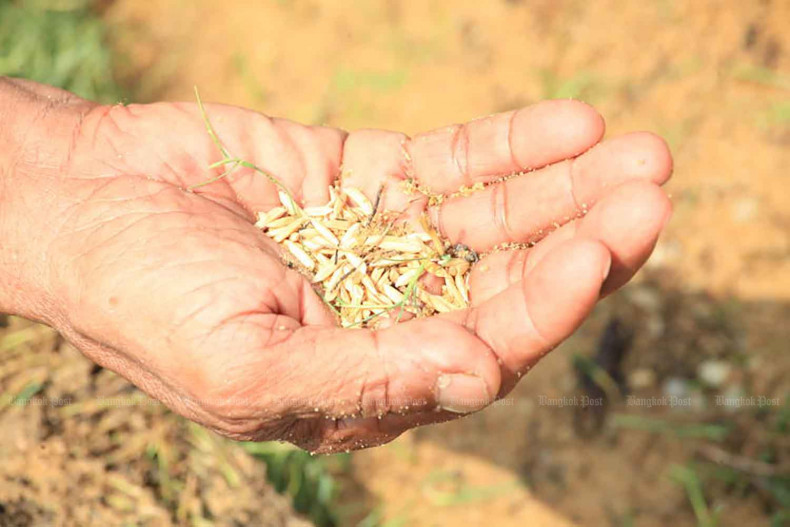Tags
Taking rice to new heights

The Rice Department wants to increase the profile of Thai rice on the global stage, by promoting unique strains with certified, geographical indication (GI) labels to a wider market.
Several farming communities in Phatthalung and Trang in the South, as well as Phayao in the North, have achieved successes in developing unique, premium rice-based products which consumers are willing to pay higher prices for. The hope, they say, is that one day they could rely on rice to generate substantial and sustainable income that would boost their quality of life.
Homegrown heroes
Jaranjit Phengrat, an agricultural specialist at the Rice Department, said native rice cultivars are an essential part of the strategy for the long-term development of Thailand’s rice sector.
“Local communities can take advantage the diversity of rice in the country, by promoting the distinctive quality of each strains, which should be accompanied by the promotion of agrotourism,” she said.
The southern provinces of Phatthalung and Trang have a massive variety of local rice strains, she said, including 182 short-grain rice and 14 glutinous rice strains, many of which have been certified as GI products. Among the most celebrated are the Khao Sang Yod from Phatthalung and Khao Bao Yod Muang from Trang.
Ms Jaranjit said the Rice Department has been supporting community enterprises in the South through the provision of rice seedlings, routine quality inspections, detailed information on packaging requirements, as well as assistance in securing alternative distribution channels.
Kanokon Yaodam, director of the Rice Research Centre in Phatthalung, said the centre distributed roughly 18 tonnes of Sang Yod rice seeds last year and 23 tonnes this year — a 20% increase — due to increased demand. Some are grown organically around the Songkhla Lake basin, in line with good agricultural practices (GAP) to ensure high quality.
Southern pride
One farming community in the area is a great example of success in producing premium organic Sang Yod rice. The enterprise’s chairman, Wisoot Wiboonphan, said the community grows 970 rai of organic Sang Yod rice.
With an average yield of about 400 kilogrammes per rai, the rice fetches 27,000 baht per tonne, much higher than conventionally grown rice, which sells around 14,000 baht per tonne on average.
Ms Kanokon said the Rice Research Centre has collected over 100 landrace rice strains from across southern Thailand for conservation and preservation. Some of the seeds have been planted in the centre’s research field, so the centre can offer more seeds back to local farmers. The centre also sends some seeds to the rice bank in Pathum Thani, and also to Denmark for rice genome preservation.
She said the department will work to have more regional rice strains labelled as GI-certified. She raised Khao Hom Hua Bon as an example, saying the rice variety will soon become a GI product of Krabi. “Khao Hom Hua Bon rice has a unique fragrance reminiscent of taro when cooked,” she said, adding it also contains high levels of antioxidants, particularly gamma oryzanol, which helps to prevent the deterioration of cells that can lead to the formation of cancer.
“We have also found the landrace rice strains are resilient to the effects of climate change, which is a major cause of lower crop yields. In the future, as we adjust to the consequences of climate change, landrace rice will be essential for increasing food security,” Ms Kanokon said.
North follows
The North, too, has enjoyed significant achievements in developing premium products from local rice grown in mountainous areas.
One of the examples is a rice farming community enterprise in Chun subdistrict in Phayao.
Chunyanut Phrawisat, leader of the enterprise, said that last year, the enterprise produced 50 tonnes of jasmine rice, brown rice, red jasmine rice, black sticky rice, and riceberry, which helped generate substantial income for the community.
Owat Yinglap, director of the Rice Product Development Division, said rice produced in Phayao owes their quality to the province’s unique soil characteristics. Rich in volcanic minerals and nutrient-laden sediments from the Mae Ing River, the area’s soil is well-suited for growing a wide variety of rice cultivars, he said.
However, Mr Owat said farmers shouldn’t rest on their laurels and rely on the province’s natural bounty. He urged farmers to adopt new ideas and technology to develop their crops and add value to their products.
Beyond grains
The kingdom has a lot of rice cultivars that can still be further developed for the benefit of local farming communities.
For instance, Mr Wisoot said, his community in Phatthalung uses modern methods and technology to add value to their premium, organic rice, by turning it into other products which could be marketed beyond traditional retail and wholesale channels.
Ms Jaranjit, from the Rice Department, said Sang Yod rice has also been developed into instant rice porridge, pizza dough, rice treats, shampoos, soaps, and other cosmetics.
Meanwhile, the La-san Samakkhi Rice Farmers Enterprise in Trang also produces rice milk, rice vermicelli flour, and cereal rice crackers using its organic GI-certified Khao Bao Yod Muang rice, which have been well-received by consumers. Various premium snacks and healthy products including crispy chocolate-coated puffed rice, rice crackers, whey protein rice and grains, and organic rice flour have also been produced from various rice strains grown in Chun subdistrict in Phayao.
https://www.bangkokpost.com/thailand/general/2861988/taking-rice-to-new-heightsPublished Date: September 9, 2024






